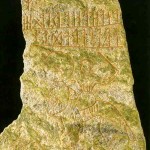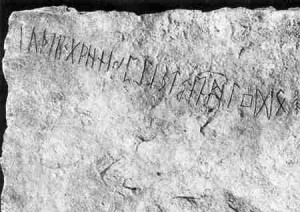The following study was written by Mr. Turgay Kürüm and is used by kind permission. The footnotes are at the end of the article and are the author’s own. This study is originally published at the following URL: http://www.antalya-ws.com/futhark/index.htm See also: www.kuzeyipekyolu.com
The Futhark alphabet was used by the North European Germanic peoples (the Swedish, Norwegian and Danish) between the 3rd and 17th centuries A.D. About 3500 stone monuments in Europe, concentrated mostly in Sweden and Norway, are claimed to have been inscribed with this writing.
The purpose of this article is to draw the readers’ attention to the fact that this Futhark alphabet, which is also called the Runic (1) stemmed from the very same origin as did the ancient Turkish (2) inscriptions with Göktürk (3) alphabet.The article is concerned solely with reading the alphabet known as “the primitive futhark”, found inscribed on a rock in Kylver on Gotland Island, Sweden, in addition to the other two stone monuments, namely the Mojbro stone in Uppland, and the Istaby stone in Blekinge, with their photographs available, and which are considered to belong to the group classified as the oldest runic inscriptions, by matching their characters with those in the Göktürk inscriptions, and thus being able to decipher them in Turkish. Further ideas, interpretations and opinions in relation to this particular subject shall not be treated within this article. I suggest that more interested readers should get in touch with us directly.
I would like to emphasize the point that I am not advocating any claim on these texts being written in the Göktürk script or vice versa. My claim is that the alphabets of these monuments found in both Europe and Central Asia have stemmed from a common origin in a very remote past. Then, it was only a natural development for the Turkish, and the Germanic tribes that, although in locations so far away from each other, they could seperately carry on with this heritage of writing. I hold the belief that I have been able to prove the claim summarized above by reading the monuments written in Futhark alphabet, or the Oldest Runic, in Turkish through the help of the Göktürk alphabet. The result submitted to your reading here is just a small part of a greater research that has been going on for the past several years (4).
The Orhun (5) monuments were discovered by a Swedish officer named Strahlenberg, and his finding was made known by publications in 1730. In 1893, the Danish scholar Thomsen was able to decipher these inscriptions and declare that they were written in Turkish (6).The monuments of Kultigin and Bilge Kagan, situated near the Kosho-Tsaydam lake in the Orhun River valley to the south of the Lake Baykal, and that of Sage Tonyukuk, the Deputy-Khan (7) a little farther, are the three important memorials which make up what is known in general as the Orhun Monuments. The inscription used on them consists 38 characters. Numerous stone monuments are also found around the Yenisei River, but they belong to a period much earlier than that of the Orhun pieces, and there are in excess of 150 Skyturkish character-forms used on. The ancient Turkish script was written vertically with the lines running from top left downwards to the bottom right, and read accordingly, that is from right to left when the text is laid down on its right side. The individual marks are not joined, and the full or partial sentences are seperated with a column mark “:” in between.
![]()
The eight vowel sounds of Turkish, are represented in couples by 4 marks, and they usually are not employed in the beginning and the middle syllables of a word, but are shown in the last syllable, or if they occur at the end. For example:
![]()
a ferocious bull, or a fire-breathing dragon (8).
![]()
The “god”, or “a deity”.
As for the Futhark alphabet employed on the stones found in Sweden, the monuments bearing this inscription are studied in two main chapters in Prof.Jansson’s study: a) The oldest runic inscriptions b) The 16-rune Futhark and Runic inscriptions from the Viking Age. The oldest runic inscriptions are written with an alphabet of 24 characters (9).The chapter, from pages 9 to 24, in Prof.Jansson’s book of 185 pages is devoted to this particular period. The three stone inscriptions which are mentioned in this part are:
– The stone from Kylver farm in Stånga (Gotland). This is the oldest relic found in Sweden, dating back to the fifth century. (p.13)
– The Möjbro stone from Uppland. (p.18)
– The Istaby stone from Blekinge. (p.21)
 Although these three monuments are declared as not deciphered yet, the author is attempting at some unfounded assumptions in relation to their contents. According to the map supplied at the end of this book, there happens to be numerous stones, which are inscribed with the same alphabet and belong to the same period of history, in more than 70 locations in the north and northwest of Europe. (Appendix A). In this article, the decipherment of the three stones mentioned above is accounted.
Although these three monuments are declared as not deciphered yet, the author is attempting at some unfounded assumptions in relation to their contents. According to the map supplied at the end of this book, there happens to be numerous stones, which are inscribed with the same alphabet and belong to the same period of history, in more than 70 locations in the north and northwest of Europe. (Appendix A). In this article, the decipherment of the three stones mentioned above is accounted.
The monuments considered to be in the 16-rune futhark group belong to a later period called the Viking Age which started at about AD. 800. During this period, the 24-characters of the Primitive Norse runes became simplified and reduced to 16-rune series.The pages 25-30 and the rest of the book in Jansson’s study are allocated to this subject which is beyond the concern of my article.
